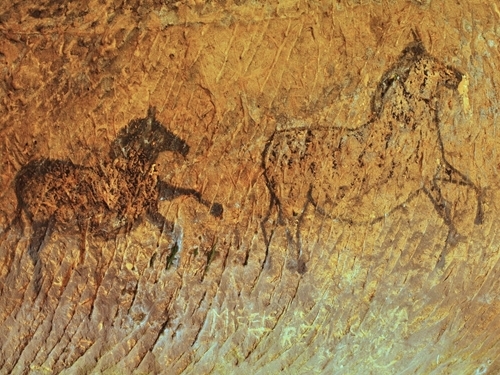The relationship between man and horse can be dated back thousands of years. According to the American Museum of Natural History, horses have roamed the planet for more than 50 million years, while the domestication of this species began around 6,000 years ago. However, there is still evidence that point to the possibility of horses and man coexisting even longer ago. One study has even analyzed DNA to better understand how humans and pre-domesticated horses interacted with each other tens of thousands of years ago.
DNA provides new perception of pre-domesticated horses
An international team of researchers headed by professors from the University of York has analyzed ancient DNA samples extracted from prehistoric cave drawings to gain more insight into the exact species of horses represented by the illustrations. The team was intrigued at how many of the Paleolithic cave paintings that depict horses had many color variations, including leopard-type spots, which contradicts previous DNA studies that allude to bay and black horses being the dominant species during these times.
The debate between archeologists and scientists is whether most of these cave paintings of spotted horses were actually reflections of authentic observations or were meant to be interpreted as metaphors. One particular drawing that has furthered this debate is “The Dappled Horses of Pech-Merle,” which was discovered in France and is considered to be approximately 25,000 years old. These type of spotted horses are referred to as spotted coat phenotypes, and it was widely assumed that they did not exist that long ago. However, part of the study involved analyzing bone and teeth samples taken from horses as far back as 35,000 years ago, finding that many of the horses indeed did share a gene that’s commonly associated in horses with leopard spotting today.
Dr. Michi Hofreiter, a professor at the University of York and one of the lead researchers in the study, elaborated that the results of the study not only indicate the prevalence of spotted horses during prehistoric ages, but also indicate that most of the paintings were indeed real life observations, without metaphorical intent.
“Our results suggest that, at least for wild horses, Paleolithic cave paintings, including the remarkable depictions of spotted horses, were closely rooted in the real-life appearance of the animals,” Hofreiter said in a press release. “While previous DNA studies have produced evidence for bay and black horses, our study has demonstrated that the leopard complex spotting phenotype was also already present in ancient horses and was accurately depicted by their human contemporaries nearly 25,000 years ago. Our findings lend support to hypotheses that argue that cave paintings constitute reflections of the natural environment of humans at the time and may contain less of a symbolic or transcendental connotation than often assumed.”
Other famous cave paintings of horses
While “The Dappled Horses of Pech-Merle” is certainly one of of the oldest and most widely recognized cave paintings to portray humans and horses interacting, it’s definitely not the only one. The Lascaux caves located in southwestern France are a series of intertwining, complex cave networks that feature a variety of ancient drawings. According to the Bradshaw Foundation, these paintings are estimated to be around 20,000 years old and depict a number of horse portrayals, many of which feature the leopard-like spots depicted in “The Dappled Horses of Pech-Merle.”
Further evolution of horses
Long before horses became known as man’s trusty sidekicks, there were around a dozen species that roamed around the Great Plains of North America approximately 10 million years ago, according to the American Museum of Natural History. Today, it’s more difficult to find horses naturally born in the wild, as many researchers trace the origins of horse domestication back to around 4,000 B.C. It’s also believed that the first horses trained by humans were significantly smaller than compared to the breeds of today, and were predominantly used for agricultural tasks rather than riding. The result of this domestication has been an everlasting bond between trainers and their horses, one that will continue to thrive for centuries to come.








